Our Guide To Keeping Your Pool Water Safe
Swimming pools are the crowning jewel of many homes, offering not just respite from the heat but also a focal point for family gatherings and leisure. However, the crystal-clear water that beckons you to take a plunge demands not just your time but a commitment to safety and hygiene. Understanding and maintaining pool water safety is paramount, not just for the health and enjoyment of its users but also to prolong the life of your pool.
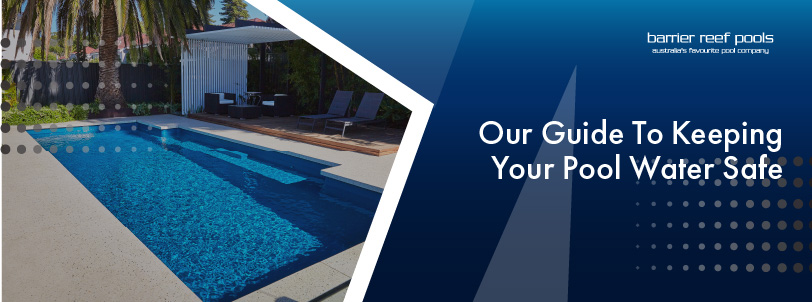
Understanding the Basics of Pool Water Chemistry
At first glance, pool maintenance might seem like a daunting task, filled with technical jargon such as ‘pH levels’ and ‘total alkalinity’ that can appear overwhelming. However, by breaking it down step by step, the process can be significantly simplified, making it manageable even for beginners.
Understanding the Importance of pH and Chlorine Levels:
The pH scale is a scientific scale running from 0 to 14, which is used to measure how acidic or alkaline your pool water is. Water in the middle of the scale, around 7, is considered neutral. Ideal pool water should have a pH level between 7.2 and 7.6 to ensure it is neither too acidic, which can damage pool equipment and irritate skin and eyes, nor too alkaline, which can decrease the effectiveness of chlorine. Speaking of chlorine, it plays a crucial role in sanitising pool water by killing bacteria and algae. For healthy pool water, chlorine levels need to be maintained within the safe range of 1 to 3 parts per million, ensuring it’s effective without being overpowering.
Identifying Signs of Imbalanced Water Chemistry:
There are several clear indicators that your pool’s chemical balance is off. If swimmers start to complain about stingy eyes or if the water becomes cloudy, there’s a good chance that the pH levels are not in the ideal range. Similarly, a strong chlorine smell, contrary to popular belief, doesn’t mean there’s too much chlorine. In fact, it’s an indicator of not enough free chlorine, resulting in the formation of chloramines.
The Crucial Role of Total Alkalinity and Calcium Hardness:
Total alkalinity and calcium hardness are parameters that, while less discussed, play a vital role in the health of your pool. Total alkalinity acts as a buffer for pH levels, helping to stabilise them and making it easier to maintain consistent pH readings. It should fall between 80 to 120 ppm. Calcium hardness, on the other hand, refers to the amount of dissolved calcium in the pool water. Maintaining calcium hardness levels between 200 to 400 ppm is crucial to prevent scaling on the pool surfaces and corrosion of pool equipment, which can result from water that’s too soft or too hard.
By understanding these key components of pool chemistry and regularly testing your pool water, you can ensure a safe and enjoyable swimming experience for everyone. Regular maintenance, although it requires a bit of learning and effort, can prevent common pool problems before they start, saving time and money in the long run.
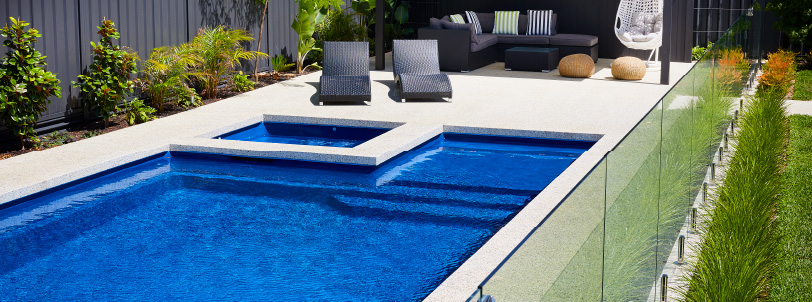
Common Pool Water Problems and Solutions
Despite adhering to a schedule of regular maintenance, pool owners can still encounter a range of common issues that negatively impact the quality of their pool water. Here’s a detailed guide on efficiently tackling these problems:
Combating Algae Growth:
The key to preventing the appearance of algae in your pool lies in the maintenance of correct chlorine levels. Chlorine acts as a powerful disinfectant that eliminates algae spores before they can multiply. Additionally, ensuring your pool benefits from good circulation, effective filtration, and regular cleaning can significantly hinder algae’s ability to take hold. Consider using an algaecide as part of your routine maintenance to offer an extra layer of protection against algae growth.
Dealing with Cloudy or Discoloured Water:
Cloudy or discoloured water is often indicative of a poor filtration system or a chemical imbalance within your pool. To combat this, ensure that you’re regularly cleaning and servicing your pool’s filter to maintain its efficiency in trapping debris and contaminants. Additionally, keeping a close eye on your pool’s water chemistry and making adjustments as necessary can help restore clarity and colour. This may involve balancing the pH, alkalinity, and chlorine levels to create an optimal environment that is less conducive to the development of cloudy water.
Addressing Foul Odour and Eye Irritation:
The presence of a foul odour or the occurrence of eye irritation among swimmers are common signs that your pool’s pH and chlorine levels are out of balance. Incorrect pH levels can render chlorine less effective as a disinfectant, leading to the proliferation of bacteria and other organisms that can cause unpleasant smells and irritate the eyes. Regular testing of your pool water is essential to detect any imbalances early. Once identified, adjusting the chemicals in your pool to maintain proper pH and chlorine levels can quickly resolve these issues, ensuring a more pleasant swimming experience.
By paying close attention to these aspects of pool maintenance and adopting a proactive approach to addressing issues as they arise, pool owners can enjoy clearer, cleaner, and healthier pool water throughout the swimming season.

Best Practices for Regular Pool Maintenance
Establishing and adhering to a maintenance schedule is crucial for keeping your pool inviting and safe.
Routine Maintenance Schedule:
Include tasks like testing water chemistry, cleaning skimmer baskets, and backwashing filters as part of your weekly routine.
Importance of Proper Filtration and Circulation:
Ensure your pool’s filter system is sized correctly for your pool and that it runs long enough each day to turn the water over at least once.
Tips for Cleaning the Pool and Maintaining Equipment:
Regular brushing and vacuuming of your pool’s walls and floor prevent algae build-up and keep water clear. Also, inspect pool equipment periodically for signs of wear or leaks.
Conclusion
Maintaining a swimming pool is undeniably a bit of an art and a science. By understanding the essentials of pool chemistry, acknowledging the signs of imbalance, and tackling common problems with strategic solutions, pool owners can significantly enhance the longevity and enjoyment of their aquatic haven. The key lies in regular, proactive maintenance and a willingness to learn about the nuances of pool care. With the right approach and consistent effort, the goal of having crystal-clear, healthy pool water is entirely achievable. Additionally, this not only ensures a safer, more enjoyable swimming experience but also protects your investment in your pool for years to come.
Our Guide To Keeping Your Pool Water Safe
Swimming pools are the crowning jewel of many homes, offering not just respite from the heat but also a focal point for family gatherings and leisure. However, the crystal-clear water that beckons you to take a plunge demands not just your time but a commitment to safety and hygiene. Understanding and maintaining pool water safety is paramount, not just for the health and enjoyment of its users but also to prolong the life of your pool.
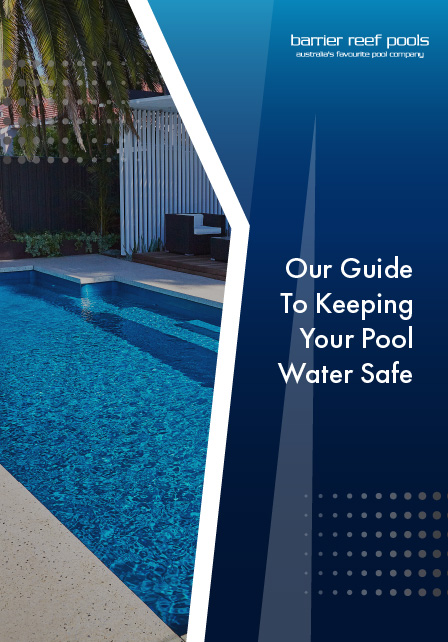
Understanding the Basics of Pool Water Chemistry
At first glance, pool maintenance might seem like a daunting task, filled with technical jargon such as ‘pH levels’ and ‘total alkalinity’ that can appear overwhelming. However, by breaking it down step by step, the process can be significantly simplified, making it manageable even for beginners.
Understanding the Importance of pH and Chlorine Levels:
The pH scale is a scientific scale running from 0 to 14, which is used to measure how acidic or alkaline your pool water is. Water in the middle of the scale, around 7, is considered neutral. Ideal pool water should have a pH level between 7.2 and 7.6 to ensure it is neither too acidic, which can damage pool equipment and irritate skin and eyes, nor too alkaline, which can decrease the effectiveness of chlorine. Speaking of chlorine, it plays a crucial role in sanitising pool water by killing bacteria and algae. For healthy pool water, chlorine levels need to be maintained within the safe range of 1 to 3 parts per million, ensuring it’s effective without being overpowering.
Identifying Signs of Imbalanced Water Chemistry:
There are several clear indicators that your pool’s chemical balance is off. If swimmers start to complain about stingy eyes or if the water becomes cloudy, there’s a good chance that the pH levels are not in the ideal range. Similarly, a strong chlorine smell, contrary to popular belief, doesn’t mean there’s too much chlorine. In fact, it’s an indicator of not enough free chlorine, resulting in the formation of chloramines.
The Crucial Role of Total Alkalinity and Calcium Hardness:
Total alkalinity and calcium hardness are parameters that, while less discussed, play a vital role in the health of your pool. Total alkalinity acts as a buffer for pH levels, helping to stabilise them and making it easier to maintain consistent pH readings. It should fall between 80 to 120 ppm. Calcium hardness, on the other hand, refers to the amount of dissolved calcium in the pool water. Maintaining calcium hardness levels between 200 to 400 ppm is crucial to prevent scaling on the pool surfaces and corrosion of pool equipment, which can result from water that’s too soft or too hard.
By understanding these key components of pool chemistry and regularly testing your pool water, you can ensure a safe and enjoyable swimming experience for everyone. Regular maintenance, although it requires a bit of learning and effort, can prevent common pool problems before they start, saving time and money in the long run.
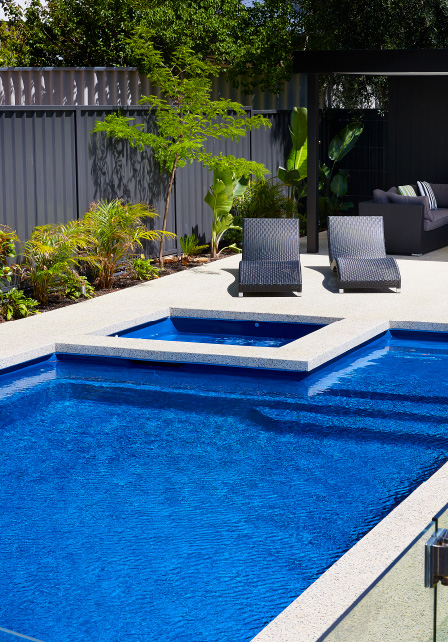
Common Pool Water Problems and Solutions
Despite adhering to a schedule of regular maintenance, pool owners can still encounter a range of common issues that negatively impact the quality of their pool water. Here’s a detailed guide on efficiently tackling these problems:
Combating Algae Growth:
The key to preventing the appearance of algae in your pool lies in the maintenance of correct chlorine levels. Chlorine acts as a powerful disinfectant that eliminates algae spores before they can multiply. Additionally, ensuring your pool benefits from good circulation, effective filtration, and regular cleaning can significantly hinder algae’s ability to take hold. Consider using an algaecide as part of your routine maintenance to offer an extra layer of protection against algae growth.
Dealing with Cloudy or Discoloured Water:
Cloudy or discoloured water is often indicative of a poor filtration system or a chemical imbalance within your pool. To combat this, ensure that you’re regularly cleaning and servicing your pool’s filter to maintain its efficiency in trapping debris and contaminants. Additionally, keeping a close eye on your pool’s water chemistry and making adjustments as necessary can help restore clarity and colour. This may involve balancing the pH, alkalinity, and chlorine levels to create an optimal environment that is less conducive to the development of cloudy water.
Addressing Foul Odour and Eye Irritation:
The presence of a foul odour or the occurrence of eye irritation among swimmers are common signs that your pool’s pH and chlorine levels are out of balance. Incorrect pH levels can render chlorine less effective as a disinfectant, leading to the proliferation of bacteria and other organisms that can cause unpleasant smells and irritate the eyes. Regular testing of your pool water is essential to detect any imbalances early. Once identified, adjusting the chemicals in your pool to maintain proper pH and chlorine levels can quickly resolve these issues, ensuring a more pleasant swimming experience.
By paying close attention to these aspects of pool maintenance and adopting a proactive approach to addressing issues as they arise, pool owners can enjoy clearer, cleaner, and healthier pool water throughout the swimming season.
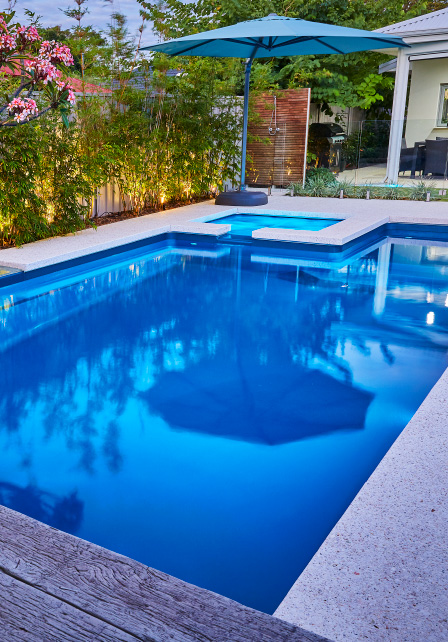
Best Practices for Regular Pool Maintenance
Establishing and adhering to a maintenance schedule is crucial for keeping your pool inviting and safe.
Routine Maintenance Schedule:
Include tasks like testing water chemistry, cleaning skimmer baskets, and backwashing filters as part of your weekly routine.
Importance of Proper Filtration and Circulation:
Ensure your pool’s filter system is sized correctly for your pool and that it runs long enough each day to turn the water over at least once.
Tips for Cleaning the Pool and Maintaining Equipment:
Regular brushing and vacuuming of your pool’s walls and floor prevent algae build-up and keep water clear. Also, inspect pool equipment periodically for signs of wear or leaks.
Conclusion
Maintaining a swimming pool is undeniably a bit of an art and a science. By understanding the essentials of pool chemistry, acknowledging the signs of imbalance, and tackling common problems with strategic solutions, pool owners can significantly enhance the longevity and enjoyment of their aquatic haven. The key lies in regular, proactive maintenance and a willingness to learn about the nuances of pool care. With the right approach and consistent effort, the goal of having crystal-clear, healthy pool water is entirely achievable. Additionally, this not only ensures a safer, more enjoyable swimming experience but also protects your investment in your pool for years to come.


